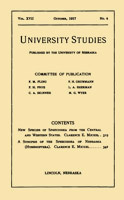University Studies of the University of Nebraska
Date of this Version
4-1914
Abstract
The main object of this investigation has been to determine the distribution of the humus, to a depth of six feet, throughout the soils in representative virgin prairies of the so-called “transition region" of Nebraska. This region is the large area which extends westward from the Missouri River for a distance of over three hundred miles and which is covered, for the most part, with loess soil. This is, agriculturally, the most important soil in the state of Nebraska, and covers more than half the area of the state. The term "transition region" is employed to convey the idea of a gradual transition from a semi-arid condition, in the western part of the loess area, to a humid condition in the eastern part.
The term " humus " in this thesis is used to represent the humified organic matter in the soil, which is soluble in dilute alkalies. By the term "soil" is meant all soil through a depth of six feet, no line being drawn between surface-soil and subsoil.
The ratio of humus to total nitrogen was determined in the case of all soils of the first and second feet, while in all first-foot soils the nitrogen content of the humus was determined.
Considerable work, also, was done during the course of this research, with a view to determining which are the most satisfactory and practical methods for the determination of the above-mentioned soil-constituents, under different conditions.


Comments
Published by the University of Nebraska.